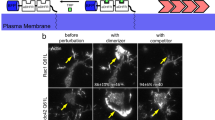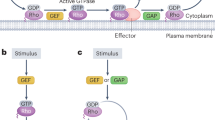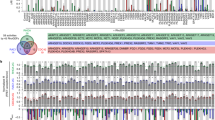Abstract
The GTPases Rac1, RhoA and Cdc42 act together to control cytoskeleton dynamics1,2,3. Recent biosensor studies have shown that all three GTPases are activated at the front of migrating cells4,5,6,7, and biochemical evidence suggests that they may regulate one another: Cdc42 can activate Rac1 (ref. 8), and Rac1 and RhoA are mutually inhibitory9,10,11,12. However, their spatiotemporal coordination, at the seconds and single-micrometre dimensions typical of individual protrusion events, remains unknown. Here we examine GTPase coordination in mouse embryonic fibroblasts both through simultaneous visualization of two GTPase biosensors and using a ‘computational multiplexing’ approach capable of defining the relationships between multiple protein activities visualized in separate experiments. We found that RhoA is activated at the cell edge synchronous with edge advancement, whereas Cdc42 and Rac1 are activated 2 μm behind the edge with a delay of 40 s. This indicates that Rac1 and RhoA operate antagonistically through spatial separation and precise timing, and that RhoA has a role in the initial events of protrusion, whereas Rac1 and Cdc42 activate pathways implicated in reinforcement and stabilization of newly expanded protrusions.
This is a preview of subscription content, access via your institution
Access options
Subscribe to this journal
Receive 51 print issues and online access
$199.00 per year
only $3.90 per issue
Buy this article
- Purchase on Springer Link
- Instant access to full article PDF
Prices may be subject to local taxes which are calculated during checkout




Similar content being viewed by others
Change history
03 September 2009
Author affiliations for P.N. were changed on 3 September 2009.
References
Jaffe, A. B. & Hall, A. Rho GTPases: biochemistry and biology. Annu. Rev. Cell Dev. Biol. 21, 247–269 (2005)
Burridge, K. & Wennerberg, K. Rho and Rac take center stage. Cell 116, 167–179 (2004)
Ridley, A. J. et al. Cell migration: integrating signals from front to back. Science 302, 1704–1709 (2003)
Kraynov, V. et al. Localized Rac activation dynamics visualized in living cells. Science 290, 333–337 (2000)
Nalbant, P., Hodgson, L., Kraynov, V., Toutchkine, A. & Hahn, K. M. Activation of endogenous Cdc42 visualized in living cells. Science 305, 1615–1619 (2004)
Pertz, O., Hodgson, L., Klemke, R. L. & Hahn, K. M. Spatiotemporal dynamics of RhoA activity in migrating cells. Nature 440, 1069–1072 (2006)
Kurokawa, K. & Matsuda, M. Localized RhoA activation as a requirement for the induction of membrane ruffling. Mol. Biol. Cell 16, 4294–4303 (2005)
Nobes, C. D. & Hall, A. Rho, rac, and cdc42 GTPases regulate the assembly of multimolecular focal complexes associated with actin stress fibers, lamellipodia, and filopodia. Cell 81, 53–62 (1995)
Rottner, K., Hall, A. & Small, J. V. Interplay between Rac and Rho in the control of substrate contact dynamics. Curr. Biol. 9, 640–649 (1999)
Nimnual, A. S., Taylor, L. J. & Bar-Sagi, D. Redox-dependent downregulation of Rho by Rac. Nature Cell Biol. 5, 236–241 (2003)
Arthur, W. T., Burridge, K. & Rho, A. Inactivation by p190RhoGAP regulates cell spreading and migration by promoting membrane protrusion and polarity. Mol. Biol. Cell 12, 2711–2720 (2001)
Ohta, Y., Hartwig, J. H. & Stossel, T. P. FilGAP, a Rho- and ROCK-regulated GAP for Rac binds filamin A to control actin remodelling. Nature Cell Biol. 8, 803–814 (2006)
Machacek, M. & Danuser, G. Morphodynamic profiling of protrusion phenotypes. Biophys. J. 90, 1439–1452 (2006)
Marguet, D., Lenne, P. F., Rigneault, H. & He, H. T. Dynamics in the plasma membrane: how to combine fluidity and order. EMBO J. 25, 3446–3457 (2006)
Raftopoulou, M. & Hall, A. Cell migration: Rho GTPases lead the way. Dev. Biol. 265, 23–32 (2004)
Zaidel-Bar, R., Ballestrem, C., Kam, Z. & Geiger, B. Early molecular events in the assembly of matrix adhesions at the leading edge of migrating cells. J. Cell Sci. 116, 4605–4613 (2003)
Del Pozo, M. A. et al. Integrins regulate GTP-Rac localized effector interactions through dissociation of Rho-GDI. Nature Cell Biol. 4, 232–239 (2002)
Nayal, A. et al. Paxillin phosphorylation at ser273 localizes a GIT1-PIX-PAK complex and regulates adhesion and protrusion dynamics. J. Cell Biol. 173, 587–599 (2006)
ten Klooster, J. P., Jaffer, Z. M., Chernoff, J. & Hordijk, P. L. Targeting and activation of Rac1 are mediated by the exchange factor β-Pix. J. Cell Biol. 172, 759–769 (2006)
Ji, L., Lim, J. & Danuser, G. Fluctuations of intracellular forces during cell protrusion. Nature Cell Biol. 10, 1393–1400 (2008)
Choi, C. K. et al. Actin and alpha-actinin orchestrate the assembly and maturation of nascent adhesions in a myosin II motor-independent manner. Nature Cell Biol 10, 1039–1050
Narumiya, S., Ishizaki, T. & Watanabe, N. Rho effectors and reorganization of actin cytoskeleton. FEBS Lett. 410, 68–72 (1997)
Yamana, N. et al. The Rho-mDia1 pathway regulates cell polarity and focal adhesion turnover in migrating cells through mobilizing Apc and c-Src. Mol. Cell. Biol. 26, 6844–6858 (2006)
Palazzo, A., Cook, T., Alberts, A. & Gundersen, G. mDia mediates Rho-regulated formation and orientation of stable microtubules. Nature Cell Biol. 3, 723–729 (2001)
Rodriguez, O. C. et al. Conserved microtubule-actin interactions in cell movement and morphogenesis. Nature Cell Biol. 5, 599–609 (2003)
Del Pozo, M. A., Price, L. S., Alderson, N. B., Ren, X. D. & Schwartz, M. A. Adhesion to the extracellular matrix regulates the coupling of the small GTPase Rac to its effector PAK. EMBO J. 19, 2008–2014 (2000)
Hodgson, L., Nalbant, P., Shen, F. & Hahn, K. Imaging and photobleach correction of Mero-CBD, sensor of endogenous Cdc42 activation. Methods Enzymol. 406, 140–156 (2006)
Hodgson, L., Shen, F. & Hahn, K. Biosensors for characterizing the dynamics of Rho family GTPases in living cells. Curr. Protoc. Cell Biol. (in the press)
Acknowledgements
We acknowledge funding from the Swiss National Science Foundation and the Novartis Foundation, formerly the Ciba-Geigy Jubilee Foundation (M.M.), NIH T32 GM008719 and NIH F30 HL094020 (C.W.), NIH R01 GM57464 (K.M.H.), NIH R01 GM71868 (G.D.), and the Cell Migration Consortium, grant U54 GM064346 from NIGMS (G.D. and K.M.H.).
Author Contributions M.M. initiated the project, conceptualized the idea of computational multiplexing, wrote all image analysis software pertinent to multiplexing, and contributed to the writing of the manuscript; L.H. developed simultaneous imaging of RhoA and Cdc42, including the modification and validation of the meroCBD probe, developed the intermolecular RhoA sensor, including controls and validation, studying the effects of biosensor stoichiometry and expression level, developed the new version of the Rac biosensor, and contributed to writing of the manuscript; C.W. produced stable cell lines of the intermolecular RhoA biosensor and conducted imaging experiments for the comparison of intra- and intermolecular biosensor designs; H.E. contributed simulations for validation of the correlation analysis and assisted with image processing; O.P. and P.N. contributed image data of RhoA and Cdc42 activity, respectively; A.A. and G.L.J. contributed valuable advice and unpublished reagents; K.M.H. and G.D. coordinated the study and wrote the final version of the manuscript and supplement.
Author information
Authors and Affiliations
Corresponding authors
Supplementary information
Supplementary Information
This file contains Supplementary Methods, Supplementary Data, Supplementary Figures S1-S10 with Legends and Supplementary References. Please note that the Movies appeared online in the wrong order and were corrected on 16th April 2010. (PDF 939 kb)
Supplementary Movie 1
This Movie shows the Rac1 activation measured using the FRET/CyPet ratio to monitor interaction between Rac1 and the p21-binding domain from PAK1 (see Figs. 1a, S1a). Left panel: corresponding time points imaged by DIC. Frame interval: 10 s. Replay: 10 frames/s. Duration of original sequence: 20 min. Magnification 40x, 2x2 binning. Scale bar: 20 µm. Colour-bar defines the dynamic range of the corrected FRET/CyPet ratio. (MOV 8200 kb)
Supplementary Movie 2
This Movie shows the zoom of the protrusive region of Movie 1. This sector of the cell edge is analyzed in Fig. 2. (MOV 4531 kb)
Supplementary Movie 3
This Movie shows the Cdc42 activation measured using the meroCBD biosensor (see Figs. 1b, S1b). Left panel: corresponding time points imaged by DIC. Frame interval: 10 s. Duration of original sequence: 13 min. Replay: 10 frames/s. Magnification 40x, 2x2 binning. Scale bar: 20 µm. Colour-bar defines the dynamic range of the merocyanine dye/EGFP ratio. (MOV 4778 kb)
Supplementary Movie 4
This Movie shows the zoom of the protrusive region of Movie 3. This sector of the cell edge is analyzed in Fig. 2. (MOV 4656 kb)
Supplementary Movie 5
This Movie shows the RhoA activation measured using the single chain, intramolecular FRET biosensor (see Figs. 1c, S1c). Left panel: corresponding time points imaged by DIC. Frame interval: 10 s. Replay: 10 frames/s. Duration of original sequence: 10 min. Magnification 40x, 2x2 binning. Scale bar: 20 µm. Colour-bar defines the dynamic range of the FRET/CFP ratio. (MOV 4506 kb)
Supplementary Movie 6
This Movie shows the zoom of the protrusive region of Movie 5. This sector of the cell edge is analyzed in Fig. 2. (MOV 5456 kb)
Supplementary Movie 7
This Movie shows sampling windows of 1.8 µm width and 0.9 µm depth placed at 0 µm and 2.5 µm from the edge follow the cell morphology. Windows are overlaid on the time lapse sequence shown in Movie 4. Frame interval: 10s. Replay: 10 frames/s. (MOV 3343 kb)
Supplementary Movie 8
This Movie shows the RhoA activation measured using the intermolecular dual chain FRET biosensor (see Figs. S1d, S10). Frame interval: 10 s. Replay: 10 frames/s. Magnification 40x, 2x2 binning. Scale bar: 20 µm. Colour-bar defines the dynamic range of the corrected FRET/CyPet ratio. (MOV 2775 kb)
Supplementary Movie 9
This Movie shows the zoomed view of protrusion and retraction activity of a randomly migrating MEF imaged simultaneously using Cdc42 and RhoA biosensors (see Fig. S7 for snapshots of the full view time sequence). Frame interval: 10s. Replay: 10 frames/s. Magnification 40x, 2x2 binning. Scale-bar: 15 μm. Colour-bar defines the dynamic range of the Cdc42 and RhoA signals. (MOV 7432 kb)
Rights and permissions
About this article
Cite this article
Machacek, M., Hodgson, L., Welch, C. et al. Coordination of Rho GTPase activities during cell protrusion. Nature 461, 99–103 (2009). https://doi.org/10.1038/nature08242
Received:
Accepted:
Published:
Issue Date:
DOI: https://doi.org/10.1038/nature08242
This article is cited by
-
Patterning of the cell cortex by Rho GTPases
Nature Reviews Molecular Cell Biology (2024)
-
Spontaneous rotations in epithelia as an interplay between cell polarity and boundaries
Nature Physics (2024)
-
Neuroligin 2 governs synaptic morphology and function through RACK1-cofilin signaling in Drosophila
Communications Biology (2023)
-
Inference of long-range cell-cell force transmission from ECM remodeling fluctuations
Communications Biology (2023)
-
Rho GTPase activity crosstalk mediated by Arhgef11 and Arhgef12 coordinates cell protrusion-retraction cycles
Nature Communications (2023)
Comments
By submitting a comment you agree to abide by our Terms and Community Guidelines. If you find something abusive or that does not comply with our terms or guidelines please flag it as inappropriate.



